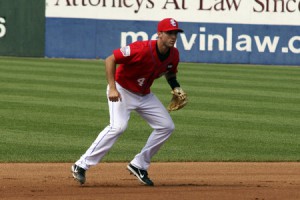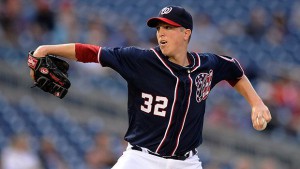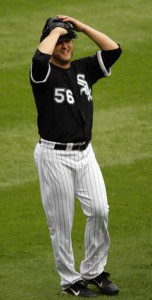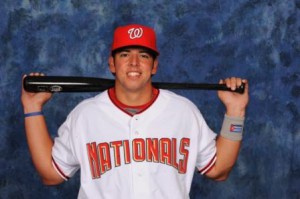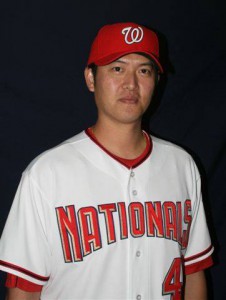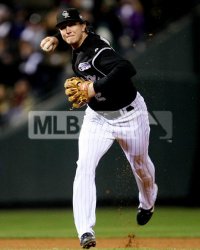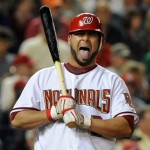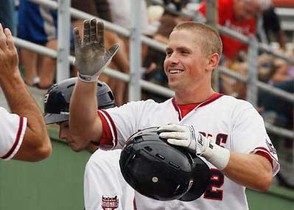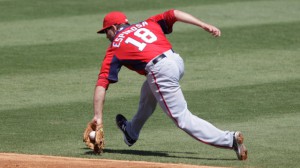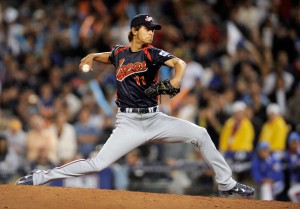
We all know how good Yu Darvish’s stats are in Japan, but how good is the competition? Photo unknown via beatofthebronx.com
Editor’s Note: this post was originally published in January of 2012: I have updated it as I have received new information several times since. But some of the information and statements may be dated based on when it was initially written (like the Yu Darvish comment in the intro). Over the years I’ve also added in more leagues and more details on existing leagues, including Wood bat leagues and Independent leagues.
I’ve always wondered, since we hear so much about players’ tearing up winter leagues or hear wonderful stat lines from players coming over from foreign countries (as we are now in the Yu Darvish mania). So what is the talent-equivalent of the various leagues outside of the conventional MLB-AAA-AA-A-rookie levels? I did a bit of digging around, asking questions and came up with the following approximations. Feel free to debate if you think otherwise.
Foreign Pro Leagues
- Japan: the Nippon Professional Baseball League rates, by various accounts, as a mid AAA-level talent league. Baseball Prospectus’ Clay Davenport did a stat-heavy analysis in 2002 and concluded that the NPB was at least AAA level, perhaps close to MLB level. However, the prevalence of mediocre players from the US going to Japan and being super-stars seems to indicate that Japan is no better than AAA, and may be a bit weaker. And, not to claim this is about talent levels per race, but there have only been a very small number of Japanese-born players who were really impact players upon arriving here.
- Cuba: per Dave Cameron (mentioned in a chat, need the link) the “general consensus” is that the Cuban pro league is about a High-A level of talent. I wonder if it isn’t higher though, given the immediate impact that a number of Cuban ex-patriots have had immediately upon their arrival in the US (Yasiel Puig, Jose Abreu being exhibits 1 and 1-a). I wonder if this will start rising now that the embargo has eased and the Cuban government has begun allowing its players to legally play elsewhere.
- Taiwan/China: Taiwan had its own thriving baseball league for a bit, but merged it into the main Chinese league in 2003. Given the small numbers of Taiwanese-born players who have made it to the majors, and the fact that the league serves mostly as a feeder into the Japanese league, its safe to say that the Chinese league is no better than a high-A level of talent.
- Korea: As with the Chinese leagues, Korea mostly feeds into the Japanese league. High-A talent levels. Might be on the rise though, as more and more 4-A/AAA veterans decamp for Korea instead of Japan. That may be driven more by money than by competition though.
- European Leagues: Believe it or not, there are thriving baseball leagues all throughout Europe. They even have multiple levels of play in certain countries (the Netherlands in particular). However, based on the levels of talent of players that typically play in Europe, its hard to put the talent levels at anything close to our own Rookie leagues. In fact, I’d suspect that most European pro teams are no better than a low division 1 college baseball program (such as GW or Catholic U’s teams).
- Mexican Summer League: listed as a AAA-quality league in places like Baseball-Reference, but studies have shown it isn’t anywhere close. A-level talent.
- Leagues elsewhere: there’s leagues just about every where else; wikipedia searches turn up baseball leagues in Australia, Asia, the far pacific. I didn’t do any research here, assuming that these leagues are one slight notch above amateur leagues in the US.
Winter Leagues
Davenport also did a bit of analysis on the various winter leagues in 2004; I’ve taken his recommendations and adjusted them based roughly on observation over the past few years, since the winter leagues have been shifting in terms of talent attracted in recent years.
Most players who go to winter leagues fall into one of three categories:
- Natives of the country looking to provide support for their home town teams and home leagues (the Nats own Ramos, Flores, Pudge, Severino and Perez being good examples)
- Players looking to get in additional work after an injury-filled year curtailed their seasons.
- Players looking to work on a new pitch, a new swing or some other experimental part of their game.
So, the talent levels in these various leagues are usually all over the road.
- Dominican Winter League: Seemingly the “best” winter league, having the most ex-patriots playing in the US. Davenport’s studies from earlier in the decade showed that the talent level is roughly equivalent to AAA talent, an opinion that I still maintain. Our own Yunesky Maya tore up the DWL last winter, but struggled to be just a serviceable pitcher in Syracuse all year.
- Puerto Rico Winter League : seems to be the 2nd strongest Winter League, but with slightly fewer MLBers than in the DWL. So we’ll call it AAA level, but weaker.
- Venezuela Winter League: The talent levels have dropped for a while, ever since political turmoil has taken over the country. This is highlighted especially close to home in 2011 with the Wilson Ramos kidnapping case. However, Nats farmhand Ryan Tatusko was kind enough to provide his opinion on the talent level and calls it “AAA talent.” I think at best its a low AAA, as the league is clearly lower quality than Puerto Rico. This last season’s version of the VWL seemed to be more talented that past versions though; perhaps this league is looking to challenge the DWL for pre-eminence in the winter leagues.
- Mexican Winter League: Its really hard to tell; the winter leagues are quite a bit better than the summer league, at least per Davenport’s studies. Now? I’d guess the MWL has degraded a bit and is probably on a par with Venezuela in terms of talent. AA-level at best.
Other US-based Professional Leagues
- Arizona Fall League: the AFL rates somewhere between a AA and AAA level by and large, though for several reasons it rates as a very heavy hitter-league (pitcher workloads and ball-parks mostly). Most of your pro teams send their top prospects from levels below AA and a number of AA and AAA (and even some guys who have MLB experience). All told, that equates with a “good” AA league. And since AA leagues are morphing into being populated with a team’s best prospects while AAA leagues are becoming repositories for “spare parts” for the MLB team, more and more the lines are blurred between AAA and AA in terms of “which team could really beat the other.” Nationals fans saw this pretty clearly during Stephen Strasburg‘s minor league career; he was hit in AA but absolutely dominated AAA teams that seemed to be populated with backup catchers and backup infielders.
- Independent Leagues: generally rates somewhere around an A-ball or slightly higher equivalent, depending on the league. They’re usually full of guys who got cut from the MLB rosters and a collection of older veterans trying to hang on. So, the younger players are (arguably) below rookie-league/short-A levels but the veterans are probably in the AAA level, bringing an average to somewhere in the A-ball range. Maybe that’s overrating the talent level in these leagues: if the guys typically playing there were that good … they’d still be on affiliated low-A and/or rookie league teams. Here’s some quick estimates by league:
- Atlantic League: High AA
- American Association: High A
- Can-Am League: High A
- Frontier League: Low A
College Leagues
- Regular NCAA Division I College Teams are probably not even as good as a Rookie league team, when balancing the entirety of the roster’s depth. I had this debate with my father recently, noting that the best Div-1 team in one recent year (South Carolina) was led by a pitcher (Mike Roth) who was a 31st round draft pick in 2011. College teams only have 11.7 scholarships to use to field a team. A good chunk of college teams are guys on partial scholarships or are complete walk-ons. Good college teams may each have a number of pro prospects, but usually only 1 or 2 legitimate prospects. On the flip side, even a rookie-level team is ENTIRELY comprised of players who were drafted, and will include high school players who signed in lieu of going to college because they were considered good enough at the time to risk signing. A college team may use a hot pitcher to beat a pro team in a theoretical 3-game series every once in a while, but a team full of professional hitters are eventually going to utterly dominate typical college bullpens, Sunday starters and mid-week players.
- Top end NCAA Division 1 College Teams, as in teams that are populated with a ton of future Pro talent, are likely the equivalent of the Advanced Short season Short-A leagues like the NY Penn league. The absolute best Div-1 teams (like a friday night match-up between nationally ranked SEC teams) may broach the equivalent of low-A teams, as discussed in this 2015 Kiley McDaniel chat here. When a college junior is highly drafted, most scouts advise that they go to at least high-A as a first stop, often saying that they’d be wasting their time in Low-A. Does this imply that high-end Division 1 teams are more the equivalent of Low-A teams? It seems so, at least at the upper cream of the crop level. Consider the talent level on the 2014-2015 Vanderbilt team with multiple first round picks, or the 2018 Florida/Oregone State teams (each of which had 3 first rounders); I’d guess that team on a whole could easily compete with some short-league teams comprised mostly of 20th and 30th round college draftees and perhaps higher. (Post publishing update May 2016: this question came up in quora.com and LA Dodger’s pitcher Brandon McCarthy provided a great answer not to terribly different from mine here. He thinks the best Div-1 teams would have a chance in a 7-game series against a low-A team, but would probably fall short due to pitching depth.
- Juco, Division II, Division III: Generally speaking a notch below the low-end Division I teams for obvious reasons. Perhaps you could make an exception for some of the higher-end Juco leagues out there (like the league that Bryce Harper played in for one year to establish draft eligibility) and claim they’re of a low-division I quality, but that might be a stretch in the grand scheme of things. So if these leagues aren’t even as strong as a low Division I team, they’re not even close to a pro-level quality. (Post-publishing update Apr 2016); read the excellent commentary from former Juco player James Pidutti, who gives some great context for the wide variety of talent in the Juco ranks these days).
Summer Wood-Bat Leagues
We have a thriving college wood bat league industry going on, with college players scattering all over the continent to play summer league baseball with wood bats. Some of these leagues are better than others; you can write a whole analysis just to try to rank the leagues (in fact, I have, but I’ve yet to publish it because I’m not sure I have it exactly right), so I’ll just use general groupings to try to rank these leagues.
- Cape Cod League: By far the most dominant wood bat league. These teams are basically Division I all star teams of players, and the numbers speak for themselves. 1100 alumni have played in the majors (about one out of every seven current major leaguers). More than half of the first round draftees last year were Cape Cod players. They are the self-proclaimed “greatest amateur league in the world” and there’s no argument. So how would a Cape Cod team fare when stacked up against a pro league? I’d put these a step above the best division 1 teams and say these are High-A equivalent teams.
- Northwoods League: After a step down from Cape Cod is Northwoods, who just had their 141st alumni debut in the majors. The calibre of players is significantly lower than in the Cape: a quick gander at the rosters for 2015 found just a handful of players from “power conference” teams on each roster. So I’m putting these teams at the same level as a “run of the mill” Division I team, or below a Rookie League team.
- The next tier of collegiate leagues, including Coastal Plains, New England Collegiate, West Coast, California Collegiate and the Alaska League: less talent than in Northwoods and thus even further away from any pro level.
- There are many more college leagues not mentioned here that probably rate as having even less talent than the already named leagues. That includes our local leagues the Cal Ripken League and the Valley League.
Semi-Pro and Amateur Teams
I’m guessing that when the old Class-B/Class-C/Class-D leagues died out in the 50s, those players then began percolating into what we now see as an improved and thriving College baseball industry, Semi-Pro leagues scattered around the country, and the (now) official Indy league designation. I always attribute the death of these low-class leagues to the advent of Television, which replaced the (usually) one source of nightly entertainment for small towns across America, which before the mid 50s would have been baseball.
Here in the DC area, there’s a “semi pro” league that is the combination of two long-standing leagues (the “Industrial League” and the “Credit Union” league) that features very good baseball. Ex division-1 players, ex Pros, good baseball. Back in the 50s this probably was a class-D level league (assuming that class-B was what has become the rookie leagues and class-C has morphed into the Independent leagues).
Summary
Here’s a table summarizing the above data, along with some clarifications from the comments after-the-fact, in order of best to least quality. (Note; the cut-n-paste below is from 2012; see the descriptions above for some updates to league talents…).
| League | US Pro Equivalent Estimate |
| Japan (NPB) | Mid AAA |
| Dominican Winter League | Mid AAA |
| Puerto Rican Winter League | Mid-Low AAA |
| Venezuelan Winter League | Low AAA/High AA |
| Arizona Fall League | Low AAA/High AA |
| Mexican Pacific (Winter) | High AA |
| Atlantic League (Ind) | High AA |
| Mexican Summer | High-A/Low AA |
| Cape Cod League | High-A |
| Cuba | High-A |
| Taiwan/China | High-A |
| Korea | High-A |
| American Association (Ind) | High-A |
| Can-Am League (Ind) | High-A |
| Frontier League (Ind) | Low-A |
| Top Division I (SEC) | Short-A |
| Other Independents | Rookie Ball |
| Division I run of the Mill | Below Rookie Ball |
| Northwoods League | Below Rookie Ball |
| European (Dutch, Italian) | Low Division 1 |
| Other upper Tier Wood Bats | Low Division 1 |
| Other Foreign (eg Australia) | Div II/Div III |
| Juco | Div II/Div III |
Do you agree/disagree with these ratings? Please feel free to comment and discuss.
